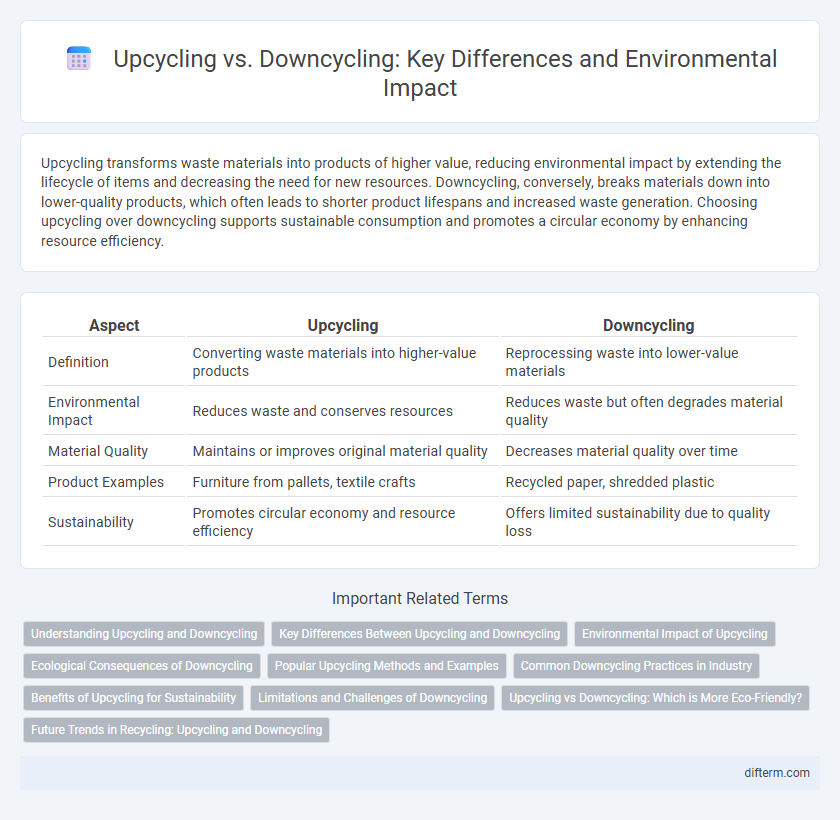Upcycling transforms waste materials into products of higher value, reducing environmental impact by extending the lifecycle of items and decreasing the need for new resources. Downcycling, conversely, breaks materials down into lower-quality products, which often leads to shorter product lifespans and increased waste generation. Choosing upcycling over downcycling supports sustainable consumption and promotes a circular economy by enhancing resource efficiency.
Table of Comparison
| Aspect | Upcycling | Downcycling |
|---|---|---|
| Definition | Converting waste materials into higher-value products | Reprocessing waste into lower-value materials |
| Environmental Impact | Reduces waste and conserves resources | Reduces waste but often degrades material quality |
| Material Quality | Maintains or improves original material quality | Decreases material quality over time |
| Product Examples | Furniture from pallets, textile crafts | Recycled paper, shredded plastic |
| Sustainability | Promotes circular economy and resource efficiency | Offers limited sustainability due to quality loss |
Understanding Upcycling and Downcycling
Upcycling transforms waste materials into products of higher value and quality, promoting resource efficiency and reducing environmental impact. Downcycling, in contrast, converts materials into lower-quality products, often limiting their lifespan and reuse potential. Understanding the distinction aids in making sustainable choices that enhance circular economy practices.
Key Differences Between Upcycling and Downcycling
Upcycling converts waste materials into products of higher quality or value, preserving resources and reducing environmental impact, while downcycling breaks materials into lower-quality products, often limiting reuse potential. Upcycling enhances material lifespan and supports circular economy principles, whereas downcycling typically leads to eventual disposal or recycling in less efficient forms. Understanding these differences is crucial for sustainable waste management and resource conservation strategies.
Environmental Impact of Upcycling
Upcycling significantly reduces environmental impact by transforming waste materials into higher-value products, thereby conserving resources and minimizing landfill contributions. This process lowers the demand for virgin materials, leading to decreased energy consumption and greenhouse gas emissions compared to traditional recycling or downcycling methods. Emphasizing upcycling promotes a circular economy that enhances sustainability and reduces overall ecological footprints.
Ecological Consequences of Downcycling
Downcycling reduces the quality and functionality of materials, leading to shorter product lifespans and increased resource extraction. This process often results in higher energy consumption and greenhouse gas emissions compared to true recycling or upcycling. Consequently, downcycling exacerbates environmental degradation and contributes significantly to waste accumulation in landfills.
Popular Upcycling Methods and Examples
Popular upcycling methods include transforming old furniture into stylish home decor, converting worn textiles into fashionable clothing or accessories, and repurposing glass jars as storage containers or lighting fixtures. These practices help reduce waste, conserve resources, and add value to discarded materials by creatively enhancing their function or design. Examples such as turning wooden pallets into garden planters or T-shirts into reusable shopping bags demonstrate practical applications of upcycling that support sustainable living.
Common Downcycling Practices in Industry
Common downcycling practices in industry include converting plastic waste into lower-quality products like park benches, carpet fibers, or plastic lumber, which limits the material's reuse potential. Paper downcycling often results in the production of lower-grade paper goods such as cardboard or tissue, reducing fiber strength and recyclability. Metal downcycling occurs when high-grade metals are mixed with impurities during recycling, leading to alloys with reduced functionality for specialized applications.
Benefits of Upcycling for Sustainability
Upcycling transforms waste materials into higher-quality products, reducing the demand for raw resources and minimizing landfill contributions, which significantly supports environmental sustainability. This process conserves energy and lowers carbon emissions compared to traditional recycling or manufacturing, enhancing resource efficiency. Upcycling encourages creative reuse and circular economy practices, fostering long-term ecological balance and reducing pollution.
Limitations and Challenges of Downcycling
Downcycling often leads to significant degradation of material quality, limiting the number of times products can be recycled and reducing their overall lifespan. It presents challenges in maintaining the original properties of materials, resulting in lower-value products that contribute to increased waste. This process also frequently requires additional processing, which consumes more energy and resources, undermining sustainability goals.
Upcycling vs Downcycling: Which is More Eco-Friendly?
Upcycling preserves the original material's value by transforming waste into higher-quality products, reducing the need for raw resources and minimizing landfill impact. Downcycling degrades material quality, often resulting in lower-value products that may eventually become waste, limiting long-term environmental benefits. Prioritizing upcycling supports circular economy principles by extending product lifecycles and reducing carbon emissions compared to downcycling.
Future Trends in Recycling: Upcycling and Downcycling
Future trends in recycling emphasize the growing importance of upcycling, which transforms waste materials into higher-value products, promoting sustainability and reducing landfill use. Downcycling remains prevalent but faces challenges due to the degradation of material quality over time, limiting its long-term effectiveness. Innovations in chemical recycling and advanced sorting technologies aim to enhance both upcycling and downcycling processes, supporting a more circular economy.
Upcycling vs Downcycling Infographic

 difterm.com
difterm.com